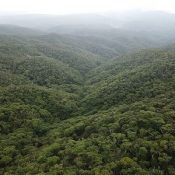
May 4, 2018 Ryukyu Shimpo online edition
In the early morning on May 4 in Japan, the International Union for Conservation of Nature (IUCN), an advisory body to the United Nations Educational Scientific and Cultural Organization (UNESCO), deferred the Japanese government’s nomination for World Natural Heritage status for a site consisting of Amami Oshima, Tokuno Island, a northern part of Okinawa Island, and Iriomote Island. The IUCN has recommended a deferral, requesting important changes to the nomination.
The IUCN pointed out that concerns remain, including the sustainability of the proposed site’s ecosystem since it is divided into minute sections.
It has requested that the site’s components be re-selected, among other actions.
In an interview at the Ministry of the Environment (MOE), Naohisa Okuda, head of the Biodiversity Policy Division of the MOE, said, “We will earnestly heed this response and consider how to handle the situation from here on out.”
The IUCN will make its final decision at the UNESCO World Heritage Committee session in Bahrain, which starts on June 24.
This is the first time that a property in Japan proposed for World Natural Heritage status was deferred.
The government will revise its nomination, but now it is most likely that the initial goal of this site achieving World Natural Heritage status by summer 2018 will not be realized.
The MOE made the proposal with confidence, and the strict nature of World Natural Heritage selection was “unforeseen,” according to a person involved with the nomination file.
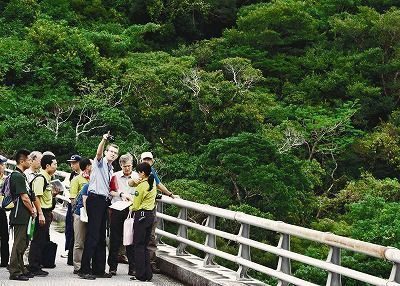
On October 16, 2017, IUCN field evaluators inspect Yambaru Forest in order to inform a decision regarding its nomination for World Natural Heritage status.
The IUCN has the option to recommend the “inscription,” “referral,” “deferral,” or “non inscription” of sites nominated for World Natural Heritage status. Because the IUCN deferred the nomination and requested a fundamental revision of the file, upon resubmission of the nomination, the IUCN will also need to revisit processes such as the field inspection.
From this point inscription on the World Heritage List takes more time than revisiting deliberations in the “referral” process, and will require at least several more years to achieve.
According to Okuda, the IUCN raised points such as that portions of the U.S. military Northern Training Area (NTA) returned in December 2016 were not included in the government’s proposal, so the IUCN recommended many amendments.
Okuda said that even if the government’s approach is called overly optimistic, that cannot be helped now.
On the other hand, he said that he does not think the influence of the NTA will negatively affect assessments of proposed areas near the NTA.
The land area proposed for World Natural Heritage status measures about 38,000 hectares, and includes a northern portion of Okinawa Island, Iriomote Island, and Kagoshima Prefecture’s islands Amami Oshima and Tokunoshima.
There are many endemic species living in the region’s subtropical evergreen forests, so due to the importance of protecting the site’s biodiversity, last year in February the Japanese government submitted a nomination file for World Natural Heritage status for this site.
(English translation by T&CT and Erin Jones)
Go to Japanese

May 4, 2018 Ryukyu Shimpo
The Okinawa International School in Sobe, Naha City, began offering Shimakutuba classes this academic year.
The class is available to all 132 students of the elementary and junior high school.
School Director Masato Chinen said, “I would like the students to learn the culture of Okinawa through Shimakutuba.”
Shimakutuba classes take place once a month for the first through sixth graders in the elementary school, and twice a month at the junior high school.
Asako Tamanaha, who is a freelance Shimakutuba instructor, teaches the elementary level.
Professor emeritus of Okinawa University Hoshin Nakamura, who specializes in language teaching, will serve as a lecturer at the junior high school.
On May 1, 30 students of the first grade took the class.
Tamanaha started with greeting saying “Haisai for boys, Haitai for girls.
” With hand gestures, Tamanaha sang in Shimakutuba “Maaru kuuganu pachin tu wariti” (a round egg was snapped and cracked).
Using both hands, she made a circle and made a movement like the flapping of a bird’s wings.
She taught the pupils how to do self-introductions while writing the example “Waa naaya XX yaibiin” (My name is XX).
Seven-year-old Yuma Otsuka gave an energetic greeting, smiled, and said, “It was my first time, but I was able to say Haisai and Haitai smoothly.”
Shimakutuba classes at public schools are mostly offered to students who belong to an extra-carricular club.
Tamanaha, who serves as a lecturer, said, “It is great that this is available to all the students of the school. I hope to give students the ability to say short sentences.”
At this school, most of the classes are conducted in English.
English is used 50 percent of the time with the first and the second graders, and 70 percent of the time with the fifth to sixth graders.
School Director Chinen said, “Language is a culture.
I want students to grasp the history and identity of Okinawa through Shimakutuba.”
(English translation by T&CT and Megumi Chibana)
Go to Japanese
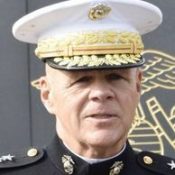
May 4, 2018 Ryukyu Shimpo
Washington Special Correspondent Yukiyo Zaha reporting
On May 2 the Commandant of the U.S. Marine Corps (CMC) General Robert B. Neller spoke about Futenma Air Station, located in Ginowan City, Okinawa. He said, “Futenma Air Base is very old. It goes back to World War II. And if you look at pictures, Futenma when it was built was … there were no people living within several kilometers. Now the cities around Futenma are right up to the fence.”
The airfield was built as a result of the U.S. military seizing land upon which a village was located while its residents were isolated in internment camps during and after the war. Neller’s comment ignores the sequence of events that led to the residents having no choice but to live near the airfield.
At this press briefing at the Department of Defense, Neller answered a question from the Ryukyu Shimpo. Neller said, “… I know the great majority of Okinawan people appreciate the American presence there, and that the great, great majority of us are good neighbors and we’re good friends.” As for the issue of Futenma relocation to Henoko, Nago City, Neller said, “We are happy to leave Futenma when we have a place to leave to go to. Until then, we’ll continue to operate and be as safe as we can.” With these words Neller made known that the plan is to continue to use Futenma Air Station, negating that Futenma be closed down next February in accordance with the five-year period that the Okinawa Prefectural Government requested from the Japanese government.
Neller confirmed that the plan to reduce the number of Marines on Okinawa remains unchanged. However, he addressed the opposition movement and said, “The Futenma Replacement Facility is going to take awhile.” He once more expressed the view that environmental issues are standing in the way of the Marine Corps plan to build live-fire ranges on Tinian Island in the Mariana Islands, upon which the plan to relocate Marines to Guam is consequent.
In terms of safety assurance Neller said, “… It would be helpful [for safety] if the people that lived around there didn’t point lasers at our airplanes, or fly kites or balloons in the flight paths…”
There were reported incidents of lasers being pointed at aircraft around Futenma, Kadena, and elsewhere in 2015. Also, when Osprey aircraft were deployed to Okinawa in 2012, residents of the surrounding areas flew kites and balloons to demonstrate their objections to the deployment, but now these actions are restricted.
(English translation by T&CT and Erin Jones)
Go to Japanese
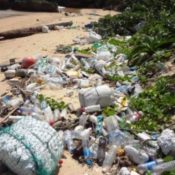
May 8, 2018 Ryukyu Shimpo
By Chie Tome
On the shores of Okinawa’s Yaeyama archipelago, Miyako Island, and Yonaguni Island, waste that contains hazardous materials such as vacuum tubes that contains substances like mercury and polyethylene waste containers is washing ashore.
This dire situation was learned March 7.
Haruyuki Yamaguchi, 69, professor emeritus of the National Defense Academy of Japan (NDA) and chairman of the Okinawa Conference on Policy Promotion for Coastal Waste, who has been studying coastal waste on the Ryukyu archipelago since 1998, calculated 20 years-worth of survey data.
Professor Yamaguchi indicated a worsening landscape and a risk to the ecosystem of these coastal regions, warning, “It is imperative we strengthen policies to reduce and further prevent waste washing up onshore from abroad.”
The survey ran from 1998 through 2017, covering 18 islands from Iheyajima in the north to Yonaguni Island to the far west for a total of 837 beaches.
Among the waste that washed ashore, nine types of oversized, hazardous, or dangerous waste, for which removal is difficult, were identified, and the survey results attempt to understand the situation for each individually.
By classification, light bulbs and mercury lamps were the most prevalent with 25,507 pieces identified, then, following in order, 8,205 fluorescent lighting tubes, 3,674 medicine bottles, and 1,020 Korean-made polyethylene tanks.
Over half of these collected on just four islands: Ishigaki, Iriomote, Miyako, and Yonaguni.
On the other four islands, trash such as rubber tires, syringes, and metallic drums were noticeable.
Within the medical waste, items such as needles and the syringes that attach to them, as well as medical tubes that contain an opaque reddish brown liquid akin to blood collection tubes were found, raising fears of contamination risk.
Professor Yamaguchi noted that in particular, the plastic syringes were structurally flimsy, and that over half of them had leaked, broken, or shattered, warning, “There is a risk of contamination in the wetlands, tidal flats, and coastlines that are the main areas of these ecosystems’ food chains.”
A majority of the polyethylene tanks were of Korean make, and it was confirmed that about 20-30% of these still contained liquid. Inside were high concentrations of dissolved lead and arsenic, as well as highly dangerous liquids that foam and have a foul odor.
Of the total 1,020 polyethylene tanks found over the past 10 years, 405 of these were collected on Iriomote Island.
Professor Yamaguchi, who spearheaded the survey, confirmed that the majority of the waste that washed ashore on Okinawa came from neighboring Asian countries such as China and Korea.
While he would like to see this get nationwide recognition, he noted that, “Currently there is no policy outside of quickly collecting the waste when it is discovered.”
The coastline, which is a valuable natural resource for Okinawa, is a “lifeline,” and he warns that neglecting it would also have economic repercussions.
Furthermore, he warned, “There needs to be more serious measures taken such as specialized organizations to deal with the coastal waste created by Okinawa Prefecture and local governments.”
(English translation by T&CT and Sam Grieb)
Go to Japanese

May 4, 2018 Ryukyu Shimpo
The “2018 Constitution Lecture Series” was held May 3, the anniversary of the enactment of the Japanese constitution, at Ginowan Community Center (hosted by The Okinawa Constitutional Association, the Okinawa Human Rights Association, and the Japan Scientists’ Association Okinawa Branch).
It has been almost one year since Prime Minister Abe Shinzo proposed an amendment to Article 9, which currently prevents Japan from establishing the capacity to wage war, which would re-define the role of the Japanese Self Defense Forces (JSDF).
In Okinawa, the plan to deploy JSDF to the Ryukyu Islands is progressing steadily. The speaker at the lecture talked about the importance of constitutionalism, while also telling the audience to think of how the current constitution has until now protected peace and human rights, urging everyone to maintain Article 9 in its current state.
All around the prefecture, there were similar assemblies, both those arguing to maintain the constitution, and those arguing to amend it.
At the Constitution Lecture Series, lawyer Makoto Ito, vice president of the Japanese Bar Federation’s constitutional issue policy bureau, which has been involved in things such as forming organizations with constitutional scholars opposing the authorization of force for collective self-defense, spoke about fundamental constitutional content and the problem with amending the constitution.
It said that revising Article 9 would become democratically valid via national vote, after which opposing things just as the deployment of the JSDF to the Ryukyu Islands, “would no longer be possible.” He warned that human rights have the potential to be suppressed in the interest of national defense and safety and that, “conscription is also a possible outcome.”
He continued that the constitution is what binds a people to its country, saying, “It is necessary to not wither, and to raise one’s voice and make the reality of the constitution close to that of its ideals.”
On Ishigaki Island, a representative from a citizen group fighting the deployment of JSDF to the island outlined the situation and activities taking place.
A lawyer also gave a performance of “Imitation Constitution Café,” which aimed to make the audience feel and care for the constitution.
Ito warns that in re-defining the role of the JSDF, “We lose the ability to renounce war.”
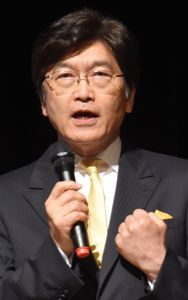
Constitutional Lawyer Makoto Ito explaining the important role of Article 9
In his keynote lecture, Makoto Ito explained that after World War 2, it was the existence of Article 9 that prevented Japan from getting wrapped up in wars with other countries, and stressed that in re-defining the role of the JSDF runs the risk of re-writing the function in Article 9 that allows Japan to renounce war.
Ito serves as the vice president of the Japanese Bar Federation’s constitutional issue policy bureau, and has been involved in lawsuits pertaining to the protection of citizen’s rights, including the “Vote-Value Disparity” lawsuit, which aimed to invalidate election results based on the idea that a vote in a smaller district had much more value than a vote in a larger one.
Ito explained an important role of the constitution, saying, “The constitution exists so that citizens can limit the power of the state. Even if we don’t care about the government or the constitution, we still have a relationship with it.”
In particular, he commented on the role of paragraph two of Article 9, saying, “It cuts off the path to waging war, by prohibiting the maintaining of a formal military.”
He raised the example of the U.S. pointing to a type of economic conscription where the poverty class is forced to join the military for economic reasons, and how soldiers returning from war experience Post-traumatic Stress Disorder (PTSD), stressing, “Whenever there is war, there is always a ‘Post-war.’ Changing Article 9 means inviting these kinds of risks.”
He indicated that the re-defining of the role of the JSDF as planned by parties such as the Liberal Democratic Party (LDP), “is the same as re-writing Article 9.” Indicating that, “new laws destroy the old ones,” he argued that even if Article 9 were to remain, there is the danger of adding articles to the constitution that would override it.
Furthermore, “the deterrent power an army possesses is also a power to provoke, making it a double-edged sword. It is necessary that the citizens of Japan remain cool-headed and be proactive.”
He said that problems such as the relocation of MCAS Futenma to Henoko were essentially the government forcing citizens to choose between “way of life” and “safety,” and that “we cannot allow being ‘forced to choose.’”
“It the responsibility of the government to provide us all with a way of life, safety, and community, as indicated in Article 13. We cannot allow people to be divided by asking them to choose one or the other.”
(English translation by T&CT and Sam Grieb)
Go to Japanese

May 4, 2018 Ryukyu Shimpo
On May 3, Ryukyu Shimpo interviewed former Prime Minister Yukio Hatoyama.
Hatoyama has been traveling Okinawa and the world even after he retired from the Diet and has been sharing his ideas on realizing peace.
Regarding the Okinawa issues in central politics, he said, “The opposition party is weak.
They should clearly say ‘No’ to Henoko and convey a message that supports Okinawa, which fights at the forefront.”
Meanwhile, regarding the Abe administration, he touched on certain issues, such as Moritomo Gakuen and the handling of the documents regarding Kake Gakuen.
He also touched on the issue of the Self-Defense Forces falsifying their daily reports.
With all these issues, he said, “They won’t last” and voiced his thought that they would come to an early dissolution.
With that in mind, he also pointed out that the concept of Japan’s obedience to the U.S. is current “national polity.”
He also appealed for necessity to create a political movement that would change that current state.
Regarding Okinawa’s state of affairs, he described a clear sense of danger.
He said, “The situation is intense. I am concerned about Governor Onaga’s health. If the next election for governor crumbles, there’s no turning back.”
He then showed his intent on continuing to work with the U.S. to change the current state of affairs.
When he had a meeting with Chinese President Xi Jinping, Hatoyama had said, “(Mr. Xi) had mentioned that we do not have the DNA to invade another country. We should believe him. There’s no point in exaggerating the threat.”
He thereby applied the brakes to the China threat theory.
He also spoke about how with the Inter-Korean summit on the Korean Peninsula is heading towards détente.
He pointed out that, “The idea that we need to improve the bases in Okinawa because there is a need to counter North Korea’s threat will soon become outdated.”
He also voiced his concerns about deploying the Self-Defense Forces missile unit to the Nansei Islands.
(English translation by T&CT and Chelsea Ashimine)
Go to Japanese
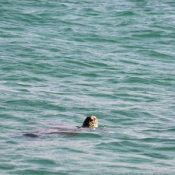
May 2, 2018 Ryukyu Shimpo
A sea turtle was found swimming in the ocean around Camp Schwab in Henoko, Nago City where a new military base is under construction.
Crushed stones continued to be poured in the ocean at the K4 site where bank protection work is undergoing. The construction site is located closed to the area where the sea turtle was found.
The length of the sea turtle’s shell was about 60 centimeters. The sea turtle is thought to be either a loggerhead sea turtle or a green turtle. The sea turtle was swimming while occasionally lifting its face out of the surface of the water.
As there was a security boat operated by the Okinawa Defence Bureau around the area, and civillian groups protesting the construction work raised their voices saying “don’t threaten turtles.”
(English translation by T&CT and Sayaka Sakuma)
Go to Japanese
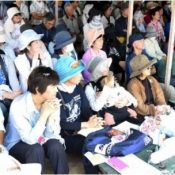
April 29, 2018 Ryukyu Shimpo
April 28 marked 66 years since the day in 1952 that the San Francisco Peace Treaty came into effect and separated Okinawa from Japanese sovereignty, known to Okinawans as a day of humiliation.
A group pledging to never forget this day of humiliation held a prefectural rally in front of the gate to Camp Schwab.
According to the organizers, about 1500 people participated. As it has now been two years since the incident in which a young Okinawan woman was sexually assaulted and killed by a former Marine, at the beginning of the gathering all participants silently prayed together for the young woman’s happiness in the next world.
This rally was held to protest Okinawa’s overlarge share of the base burden, and to speak up against things related to Futenma Air Station’s relocation to Henoko such as the construction of a new base and the revision of Article 9 of the Constitution.
Tetsumi Takara, the head of the action committee of the group that organized the rally and a professor at the University of the Ryukyus’ Graduate School of Law, spoke on behalf of the rally’s organizers.
Talking about the day of humiliation, he said, “Our thoughts have been ignored. Okinawa was estranged from the Constitution, and our fundamental human rights, pacifism, and sovereignty have been removed from us.
” He went on speak about the new base in Henoko, saying, ”
Our sentiment against the base being built is also being ignored. Our humiliation has stretched on for 70 years.” Takara’s words criticized Japan’s stance on these issues.
Mamoru Nakamura of the Okinawa-Ken Toitsuren touched on the incident of the ex-Marine assaulting and killing the young Okinawan woman two years ago.
He mentioned, “Her father said, ‘It is an incident that occurred due to the presence of military bases. I wish that all U.S. military bases did not exist.’ With this considered, actions such as building a new base are unreasonable.”
The rally also addressed that the objectives of denuclearization efforts brought up in the inter-Korea summit on April 27 have been verified.
Emiko Miyagi, a representative of the Okinawa Peace Citizens’ Network said, “I support this move by North and South Korea, I don’t want to let them backtrack. If they can achieve peace, soon the bases here will not be needed.”
The construction of a new base in Henoko will continue in Oura Bay.
Chief Secretary Koshin Nakamoto of the Helicopter Base Objection Association spoke in a low voice, saying, “In the morning work will be conducted on the ocean. That place is the dugongs’ feeding ground. There are also precious corals there, and my heart aches badly for them.”
The rally participants raised the message: “From here on out, a matter of great importance is the activities of the Island-Wide Council. Let’s fight from this region to change politics.”
(English translation by T&CT and Erin Jones)
Go to Japanese
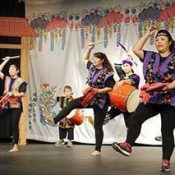
April 30, 2018 Ryukyu Shimpo
By Special Corresponded Tamiko Suzuki
Washington D.C. – It has been 35 years since Jesse Shokan Shima gathered 27 people at his home, and started the Okinawa Kai of Washington D.C. Since then, the Okinawa Kai has grown to over 200 famlies in the Washington D.C. area, both those of Okinawan descent as well those with an interest in the island chain.
On April 21, they celebrated their 35th anniversary with great fanfare at a middle school in Alexandria, Virignia.
Itsuko Asato, president of the organization, chose the theme of “Ichibari Cho-de” – “Once we have met, we are like brothers & sisters,” for the celebration, and greeted the audience saying, “Let’s take a new step with our 35th year, and grow the organization together.”
The celebration itself was lively, attracting around 400 people from different U.S. states.
In the celebration, members presented the founders of Okinawa Kai, who worked for years in service of the organization, with a letter of gratitude.
There was also a birthday celebration for two members aged 85 and 73.
For the younger members, the organization awarded scholarships to two students, the 35th anniversary special scholarship and the 2017 scholarship.
On stage, the anniversary was celebrated with a variety of entertainment.
There was a performance of a Ryukyuan Dance, “Kagiya de fu.” A taiko drumming group from Richmond, Virginia perfumed an arrangement of “Eisa” and “Yatai-bayashi” to the roars of the crowd.
Four grandmasters from the Tamagusku Ryu Shosetsu Kai and the Tamagusuku Ryu Keisho Kai perfomed traveled from Okinawa to perform traditional Ryukyu dances.
After the performances, the masters where presented with a certificate of gratitude.
There were also performances such as dancing, shamisen, koto, and karate.
For the finale, the Okinawa Kai Eisa group gave a lively performance, capping off the night with the well-known dance Kachashi.
(English translation by T&CT and Sam Grieb)
Go to Japanese
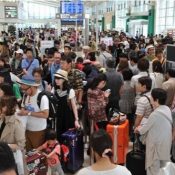
April 26, 2018 Ryukyu Shimpo
On April 25, the Okinawa Prefectural Government (OPG) announced that compared to fiscal year (FY) 2016, FY 2017 saw a 9.2% increase in incoming tourists, or 809,800 more people, for a record high of 9,579,000.
There were several factors that contributed to this overall increase. First, there was an expansion of domestic air routes, such as direct flights to and from remote islands.
Secondly, there were more foreign tourists due to increased foreign air routes.
Lastly, the number of times cruise ships stopped at ports increased.
For FY 2018, the OPG aims to achieve 10 million tourists or a 4.4% increase compared to FY 2017. The OPG plans to reinforce their strategies for attracting tourists and receiving them.
The breakdown of FY 2017’s tourists were: 6,887,000 domestic tourists (+3.7% compared to the previous year) and 2,692,000 foreign tourists (+26.4%).
All months in FY 2017 had surpassed its numbers from the previous year.
In August, for the first time ever, the number of tourists reached one million in a single month.
Breaking down the foreign tourists by location, 813,000 (+24.7%) were from Taiwan, 546,000 (+25.4%) were from mainland China, and 544,800 (+20.5%) were from Korea.
The increase in mainland Chinese tourists was a result of an increase in the number of times a cruise ship stopped at ports.
The increase in Korean tourists was due to the newly established Daegu air route.
The year-round flights to and from Bangkok and new Singapore routes also supported the overall increase.
The goal of reaching 10 million tourists in FY 2018 is a year ahead of schedule compared to the Fifth Prefectural Tourism Development Basic Plan.
The plan had already been adjusted upward last year.
On April 25, Lieutenant Governor Moritake Tomikawa held a press conference at the prefectural office.
He said, “The OPG will move forward with effective promotional development, human resources development, and improving the system for receiving foreign tourists visiting Japan in order to achieve the 10 million goal for fiscal year 2018.”
(English translation by T&CT and Chelsea Ashimine)
Go to Japanese


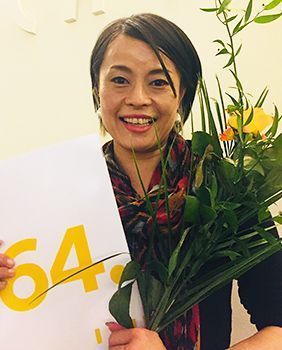










 Webcam(Kokusai Street)
Webcam(Kokusai Street)


